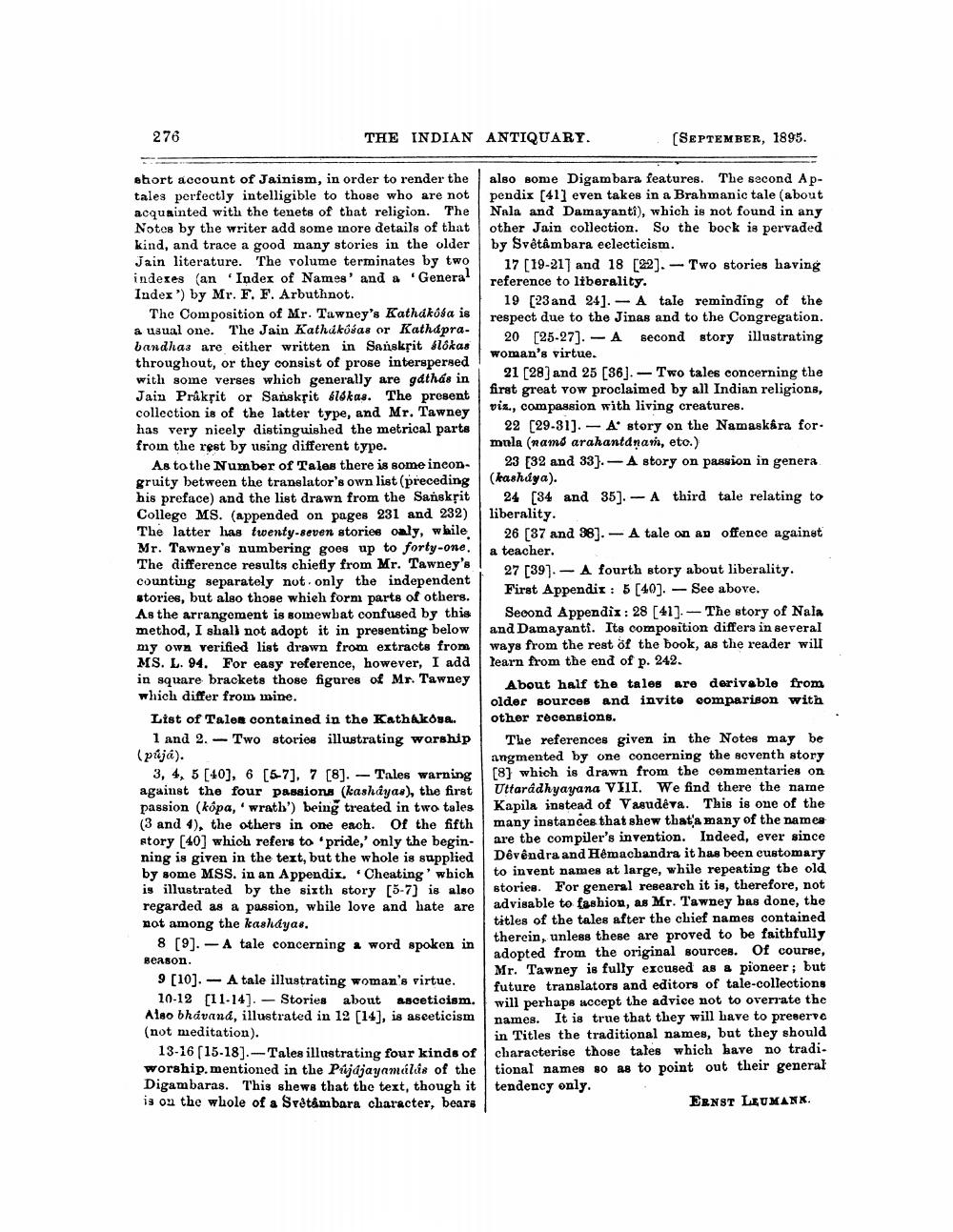________________
276
THE INDIAN ANTIQUARY
(SEPTEMBER, 1895.
short account of Jainism, in order to render the also some Digambara features. The second Aptales perfectly intelligible to those who are not pendix [41] even takes in a Brahmanic tale (about acquainted with the tenets of that religion. The Nala and Damayanti), which is not found in any Notes by the writer add some more details of that other Jain collection. So the bock is pervaded kind, and trace a good many stories in the older by Svētâmbara eelecticism. Jain literature. The volume terminates by two 17 (19-21] and 18 [22]. -Two stories having indexes (an "Index of Names' and a General
reference to liberality. Index') by Mr. F. F. Arbuthnot.
19 [23 and 24). - A tale reminding of the The Composition of Mr. Tawney's Kathakosa is
respect due to the Jinas and to the Congregation. a usual one. The Jain Kathukósas or Kathaprabandhas are either written in Sanskrit Slokas
20 [25-27]. - A second story illustrating
woman's virtue. throughout, or they consist of prose interspersed! with some verses which generally are gathás in
21 [28] and 25 [36]. - Two tales concerning the Jain Praksit or Sanskpit klókas. The present
first great vow proclaimed by all Indian religione, collection is of the latter type, and Mr. Tawney
viz., compassion with living creatures. has very nicely distinguished the metrical parts 22 [29-31]. – A story on the Namaskara forfrom the rest by using different type.
mula (namd arahantanań, etc.) As to the Number of Tales there is some incon- 23 [32 and 33).- A story on passion in genera gruity between the translator's own list (preceding
(lashiya). his preface) and the list drawn from the Sanskrit 24 (34 and 35]. - A third tale relating to College MS. (appended on pages 231 and 232) liberality. The latter has twenty-seven stories only, while 26 [37 and 38]. - A tale on an offence against Mr. Tawney's numbering goes up to forty-one. I a teacher. The difference results chiefly from Mr. Tawney's !
27 [39]. - A fourth story about liberality. counting separately not only the independent stories, but also those which form parts of others.
First Appendix : 5 [40]. - See above. As the arrangement is somewbat confused by this Second Appendix: 28 [41]. - The story of Nala method, I shall not adopt it in presenting below and Damayanti. Its composition differs in several my own verified list drawn from extracts from ways from the rest of the book, as the reader will MS. L. 94. For easy reference, however, I add learn from the end of p. 242. in square brackets those figures of Mr. Tawney
About half the tales are derivable from which differ from mine.
older sources and invite comparison with List of Tales contained in the Kathakosa. other recensions.
1 and 2. - Two stories illustrating worship The references given in the Notes may be (půjá).
angmented by one concerning the soventh story 3, 4, 5 [40), 6 (5-7), 7 [8]. – Tales warning 18) which is drawn from the commentaries on against the four passions (kashdyas), the first | Uttaradhyayana VIII. We find there the name passion (kópa,' wrath') being treated in two tales Kapila instead of Vasudeva. This is one of the (3 and 4), the others in one each. Of the fifth many instances that shew that'a many of the names story [40] which refers to 'pride,' only the begin
are the compiler's invention. Indeed, ever since ning is given in the text, but the whole is supplied Dôvêndra and Hemachandra it has been customary by some MSS. in an Appendix. Cheating' which
to invent names at large, while repeating the old is illustrated by the sixth story [5-7) is also
stories. For general research it is, therefore, not regarded as a passion, while love and hate are advisable to fashion, as Mr. Tawney bas done, the not among the kashayas.
titles of the tales after the chief names contained 8 [9]. – A tale concerning a word spoken in
therein, unless these are proved to be faithfully Beason.
adopted from the original sources. Of course,
Mr. Tawney is fully excused as a pioneer ; but 9 [10]. - A tale illustrating woman's virtue.
future translators and editors of tale-collections 10-12 [11-14). - Stories about asceticism. will perhaps accept the advice not to overrate the Also bhávand, illustrated in 12 [14], is asceticism names. It is true that they will have to preserve (not meditation).
in Titles the traditional names, but they should 13-16 (15-18].--Tales illustrating four kinds of characterise those tales which have no tradi. worship. mentioned in the Pújdjayamals of the tional names so as to point out their general Digambaras. This shews that the text, though it tendency only. is on the whole of a Svátâmbara character, bears
ERNST LEUMANK.




